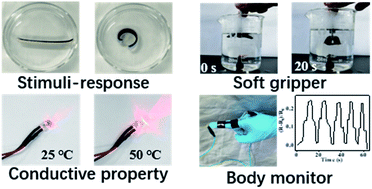Multi-responsive and conductive bilayer hydrogel and its application in flexible devices†
Abstract
Multi-stimuli-responsive hydrogels are intelligent materials that present advantages for application in soft devices compared with conventional machines. In this paper, we prepared a bilayer hydrogel consisting of a poly(2-(dimethylamino)ethyl methacrylate) layer and a poly(N-isopropylacrylamide) layer. The hydrogel responded to temperature, pH, NaCl, and ethanol by undergoing bending deformation. At 40 °C, it only took 23 s for the hydrogel to bend nearly 300°. Carbon black was also introduced into the hydrogel network to render it conductive. Based on its multi-stimuli-responsive properties and conductivity, the hydrogel was used to construct a 4-arm gripper, thermistor, and finger movement monitor. The time required to grip and release an object was 141 s. The resistance changed with temperature, which affected the brightness of an LED. Finger motions were monitored, and the bending angle could be distinguished.



 Please wait while we load your content...
Please wait while we load your content...